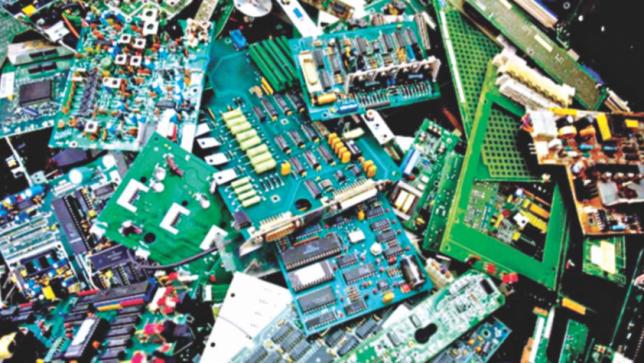Electronic waste disposal rules on the cards

The government is framing rules to ensure proper management of electronic waste (e-waste) such as handsets, computers and electrical items, which tend to be dumped haphazardly, posing risks to the environment and public health.
The move comes in the face of increasing generation of e-waste owing to rising use of electrical and electronic devices in the country.
The growth rate of e-waste generation is about 20 percent per year, according to a study by the Bangladesh University of Engineering and Technology.
The study carried out last year found that the amount of e-waste rose to 4 lakh tonnes in 2018 from 1.30 lakh tonnes in 2010. The volume is projected to be 46.2 lakh tonnes by 2035.
The e-wastes contain a number of toxic substances, including lead, chromium, and plastic additives, so their indiscriminate dumping poses health and environmental risks.
Once the rule is in place, consumers will not be able to throw away their obsolete electronic devices any place they like; rather they will have to deposit their e-waste to stores or collection centres.
Similarly, manufacturers and assemblers of the devices will have to collect e-waste either for reuse or destruction during production of electrical and electronic goods and ensure delivery of the e-wastes to the registered repairers, dismantlers and recyclers, according to the draft rules on management of wastes generated from electrical and electronic goods.
Not only that, companies would be responsible for establishing collection centres alone or collectively to store destroyed electrical and electronic goods.
“We have finalised the rules and sent it the ministry,” said Mirza Shawkat Ali, director of climate change & international convention of the Department of Environment.
The draft would be sent to the law ministry soon for vetting.
The e-wastes, which are often rich in precious metals and other reusable materials such as plastics, are also perceived as a source of additional income by the low-income and unemployed population.
Recycling of scrap and second-hand electrical equipment is a profitable business in developing countries like Bangladesh and 13,300 tonnes of e-wastes enter into the recycling business every year, the study said.
“The workers involved in e-waste handling, dismantling and recycling are at risk of carcinogenic and non-carcinogenic health hazards through inhalation of toxic elements such as lead, cadmium and chromium,” the report said.
It said the awareness level among the workers regarding the health impacts of e-waste is almost non-existent.
“Weathering actions and chemical reactions accelerate leaching of hazardous elements from e-wastes and release those in air, water and soil and thereby pose a serious threat to the environment.”
The government took the step to frame the electronic waste management rules in 2012. But it is yet to finalise the document.
The draft rule said manufacturers, assemblers, stores, recyclers, repairer and dismantlers will have to get registered with the DoE.
In addition, manufacturers and assemblers will have to do awareness campaigns regarding the presence of dangerous elements in electrical and electronic goods and the risk related to improper management, dismantling and disposal of e-wastes, according to the draft.
Companies will also have to keep records related to e-waste management and furnish a report to the DoE within 60 days of a fiscal year's end.
Not only that, manufacturers and assemblers will have some extended responsibilities that include providing financial incentives to consumers for return of expired, unused, malfunctioned goods and submission of plans describing the target of collection of e-waste.
The draft rules seek that dismantlers and recyclers get clearance from the DoE and make sure that there will be no risk to environment and public health for storing, transporting, dismantling and recycling of the e-waste.
Export of the e-waste would be encouraged if there is no required arrangement for recycling and reuse of the goods, according to the draft.
The draft says the e-waste cannot be stored for more than 180 days. Every manufacturer will have to take steps to reduce the use of dangerous elements within five years from the effective date of the rule.
And all the information related to the presence and reduction of the dangerous element in the electrical and electronic goods should be presented in the product information booklet, according to the draft.
“Once the rule is framed, we want to sit with the companies, particularly big importers and producers, in order to implement it step by step,” Ali said.
The DoE will encourage businesses to comply with the rules voluntarily.
“We want to play a facilitating role. We will encourage them, facilitate them. We do not want to go for any tough measure initially. We do not want to affect our industrialisation.”
